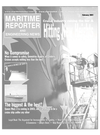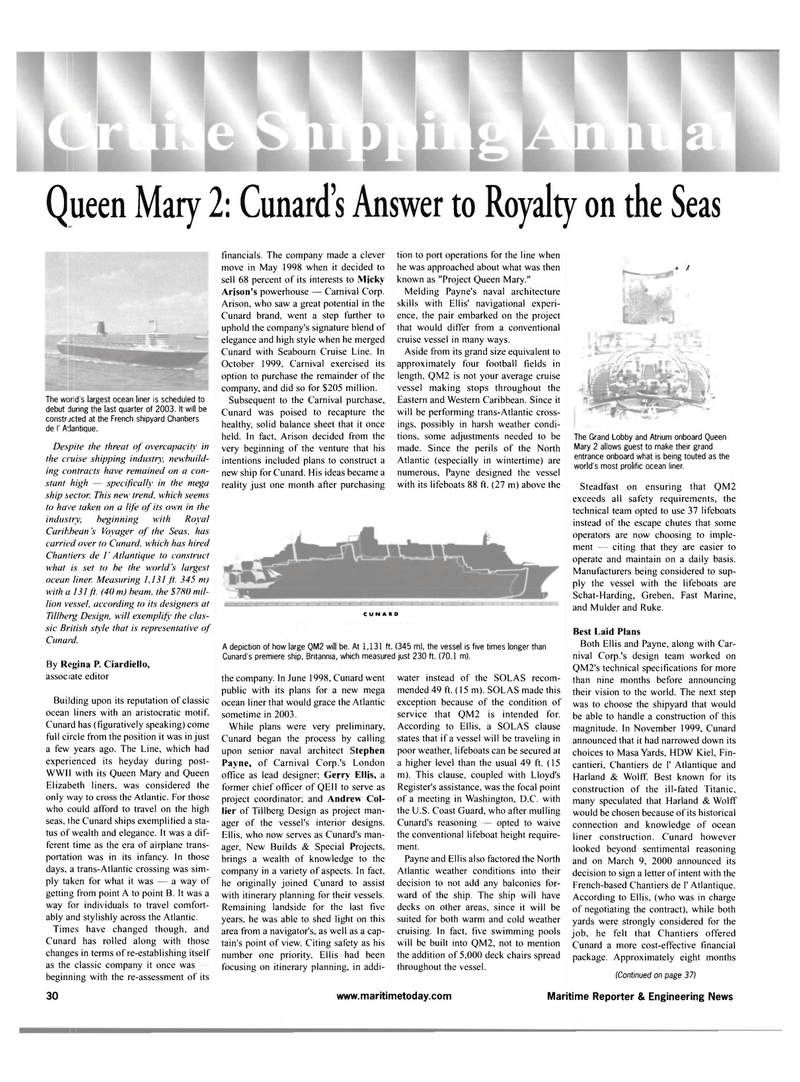
Page 30: of Maritime Reporter Magazine (February 2001)
Read this page in Pdf, Flash or Html5 edition of February 2001 Maritime Reporter Magazine
Queen Mary 2: Cunard's Answer to Royalty on the Seas
The world s largest ocean liner is scheduled to debut during the last quarter of 2003. It will be constructed at the French shipyard Chantiers de I' Atlantique.
Despite the threat of overcapacity' in the cruise shipping industry', newbuild- ing contracts have remained on a con- stant high — specifically in the mega ship sector. This new trend, which seems to have taken on a life of its own in the industry, beginning with Royal
Caribbean's Voyager of the Seas, has carried over to Cunard, which has hired
Chantiers de 1' Atlantique to construct what is set to be the world's largest ocean liner. Measuring 1,131 ft. 345 m) with a 131 ft. (40 m) beam, the $7X0 mil- lion vessel, according to its designers at
Tillberg Design, will exemplify the clas- sic British style that is representative of
Cunard.
By Regina P. Ciardiello, associate editor
Bui lding upon its reputation of classic ocean liners with an aristocratic motif.
Cunard has (figuratively speaking) come full circle from the position it was in just a few years ago. The Line, which had experienced its heyday during post-
WW1I with its Queen Mary and Queen
Elizabeth liners, was considered the only way to cross the Atlantic. For those who could afford to travel on the high seas, the Cunard ships exemplified a sta- tus of wealth and elegance. It was a dif- ferent time as the era of airplane trans- portation was in its infancy. In those days, a trans-Atlantic crossing was sim- ply taken for what it was a way of getting from point A to point B. It was a way for individuals to travel comfort- ably and stylishly across the Atlantic.
Times have changed though, and
Cunard has rolled along with those changes in terms of re-establishing itself as the classic company it once was beginning with the re-assessment of its financials. The company made a clever move in May 1998 when it decided to sell 68 percent of its interests to Micky
Arison's powerhouse Carnival Corp.
Arison, who saw a great potential in the
Cunard brand, went a step further to uphold the company's signature blend of elegance and high style when he merged
Cunard with Seabourn Cruise Line. In
October 1999. Carnival exercised its option to purchase the remainder of the company, and did so for $205 million.
Subsequent to the Carnival purchase,
Cunard was poised to recapture the healthy, solid balance sheet that it once held. In fact, Arison decided from the very beginning of the venture that his intentions included plans to construct a new ship for Cunard. His ideas became a reality just one month after purchasing the company. In June 1998, Cunard went public with its plans for a new mega ocean liner that would grace the Atlantic sometime in 2003.
While plans were very preliminary,
Cunard began the process by calling upon senior naval architect Stephen
Payne, of Carnival Corp.'s London office as lead designer; Gerry Ellis, a former chief officer of QEII to serve as project coordinator; and Andrew Col- lier of Tillberg Design as project man- ager of the vessel's interior designs.
Ellis, who now serves as Cunard's man- ager, New Builds & Special Projects, brings a wealth of knowledge to the company in a variety of aspects. In fact, he originally joined Cunard to assist with itinerary planning for their vessels.
Remaining landside for the last five years, he was able to shed light on this area from a navigator's, as well as a cap- tain's point of view. Citing safety as his number one priority, Ellis had been focusing on itinerary planning, in addi- tion to port operations for the line when he was approached about what was then known as "Project Queen Mary."
Melding Payne's naval architecture skills with Ellis' navigational experi- ence, the pair embarked on the project that would differ from a conventional cruise vessel in many ways.
Aside from its grand size equivalent to approximately four football fields in length, QM2 is not your average cruise vessel making stops throughout the
Eastern and Western Caribbean. Since it will be performing trans-Atlantic cross- ings. possibly in harsh weather condi- tions, some adjustments needed to be made. Since the perils of the North
Atlantic (especially in wintertime) are numerous, Payne designed the vessel with its lifeboats 88 ft. (27 m) above the water instead of the SOLAS recom- mended 49 ft. (15 m). SOLAS made this exception because of the condition of service that QM2 is intended for.
According to Ellis, a SOLAS clause states that if a vessel will be traveling in poor weather, lifeboats can be secured at a higher level than the usual 49 ft. (15 m). This clause, coupled with Lloyd's
Register's assistance, was the focal point of a meeting in Washington, D.C. with the U.S. Coast Guard, who after mulling
Cunard's reasoning — opted to waive the conventional lifeboat height require- ment.
Payne and Ellis also factored the North
Atlantic weather conditions into their decision to not add any balconies for- ward of the ship. The ship will have decks on other areas, since it will be suited for both warm and cold weather cruising. In fact, five swimming pools will be built into QM2, not to mention the addition of 5,000 deck chairs spread throughout the vessel. $ 1
The Grand Lobby and Atrium onboard Queen
Mary 2 allows guest to make their grand entrance onboard what is being touted as the world's most prolific ocean liner.
Steadfast on ensuring that QM2 exceeds all safety requirements, the technical team opted to use 37 lifeboats instead of the escape chutes that some operators are now choosing to imple- ment — citing that they are easier to operate and maintain on a daily basis.
Manufacturers being considered to sup- ply the vessel with the lifeboats are
Schat-Harding, Greben, Fast Marine, and Mulder and Ruke.
Best Laid Plans
Both Ellis and Payne, along with Car- nival Corp.'s design team worked on
QM2's technical specifications for more than nine months before announcing their vision to the world. The next step was to choose the shipyard that would be able to handle a construction of this magnitude. In November 1999, Cunard announced that it had narrowed down its choices to Masa Yards, HDW Kiel, Fin- cantieri, Chantiers de 1' Atlantique and
Harland & Wolff. Best known for its construction of the ill-fated Titanic, many speculated that Harland & Wolff would be chosen because of its historical connection and knowledge of ocean liner construction. Cunard however looked beyond sentimental reasoning and on March 9, 2000 announced its decision to sign a letter of intent with the
French-based Chantiers de 1' Atlantique.
According to Ellis, (who was in charge of negotiating the contract), while both yards were strongly considered for the job, he felt that Chantiers offered
Cunard a more cost-effective financial package. Approximately eight months (Continued on page 37)
C U N A R O
A depiction of how large QM2 will be. At 1,131 ft. (345 m), the vessel is five times longer than
Cunard's premiere ship, Britannia, which measured just 230 ft. (70.1 m). 30 www.maritimetoday.com Maritime Reporter & Engineering News

 29
29

 31
31
